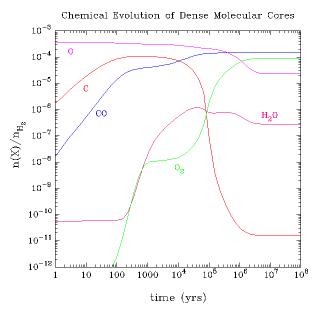
(Figure 4)
As an example of the importance of these species to the
chemical evolution of molecular clouds, most of the nearly 100
molecular species that have been identified in the interstellar medium
have abundances relative to the dominant hydrogen molecule (H ) that
are less than one part in 100 million (1 x 10
) that
are less than one part in 100 million (1 x 10 ), but the relative abundance of O
), but the relative abundance of O is
predicted to be 9 x 10
is
predicted to be 9 x 10 and that of water
and that of water
is 3 x 10 .
.
While the CO molecule, and numerous lesser abundant molecules, are readily
observable from ground-based observatories, both
O and H
and H O
cannot be observed in the cold environment typical of molecular clouds because
of blockage from the Earth's atmosphere. Using special techniques, such as
observations of isotopic water,
H
O
cannot be observed in the cold environment typical of molecular clouds because
of blockage from the Earth's atmosphere. Using special techniques, such as
observations of isotopic water,
H
 O,
from NASA's Kuiper Airborne Observatory,
some limits have been set on the abundances of water and molecular oxygen at
single positions in a handful of cloud cores. However, the abundances of
these key components of the interstellar medium remain poorly constrained
by current observations and these observations have provided
no information on their spatial distribution.
O,
from NASA's Kuiper Airborne Observatory,
some limits have been set on the abundances of water and molecular oxygen at
single positions in a handful of cloud cores. However, the abundances of
these key components of the interstellar medium remain poorly constrained
by current observations and these observations have provided
no information on their spatial distribution.
With the space-based platform of SWAS, astronomers will be able
for the first time to directly observe
O and
H
and
H O over many
positions in numerous molecular cloud cores. A primary goal will be to
detect or set an upper limit on the water and molecular oxygen abundance
(relative to H
O over many
positions in numerous molecular cloud cores. A primary goal will be to
detect or set an upper limit on the water and molecular oxygen abundance
(relative to H )
For molecular oxygen the detection limit is below most of the
predictions from current chemical models and detection of the emission from
these species will have important consequences
on the theories of the evolution of molecular clouds and the process of
star formation.
)
For molecular oxygen the detection limit is below most of the
predictions from current chemical models and detection of the emission from
these species will have important consequences
on the theories of the evolution of molecular clouds and the process of
star formation.
[Back]